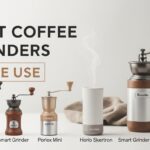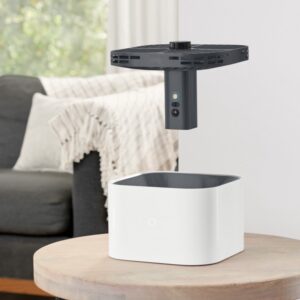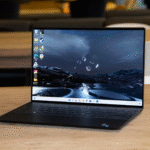Finding the right coffee machine for home use can feel overwhelming with so many options promising barista-level results.
At bestforhomeuse.com, we’ve tested dozens of models to see which truly deliver when used every day in a home setting. From compact pod systems to fully automatic espresso machines, the right choice depends on your kitchen space, brewing preferences, and budget.
A well-chosen coffee maker for home use doesn’t just save you time in the morning—it elevates your daily routine with consistent flavor, easy operation, and reliable performance.
In this guide, we’ll share our hands-on reviews of the best coffee machines for home use in 2025, explain how we tested them, and provide insights you can trust to make the right decision for your household.
Best Coffee Machines For Home Use
1. Breville Barista Express Impress – Best Espresso Coffee Machine for Home Use
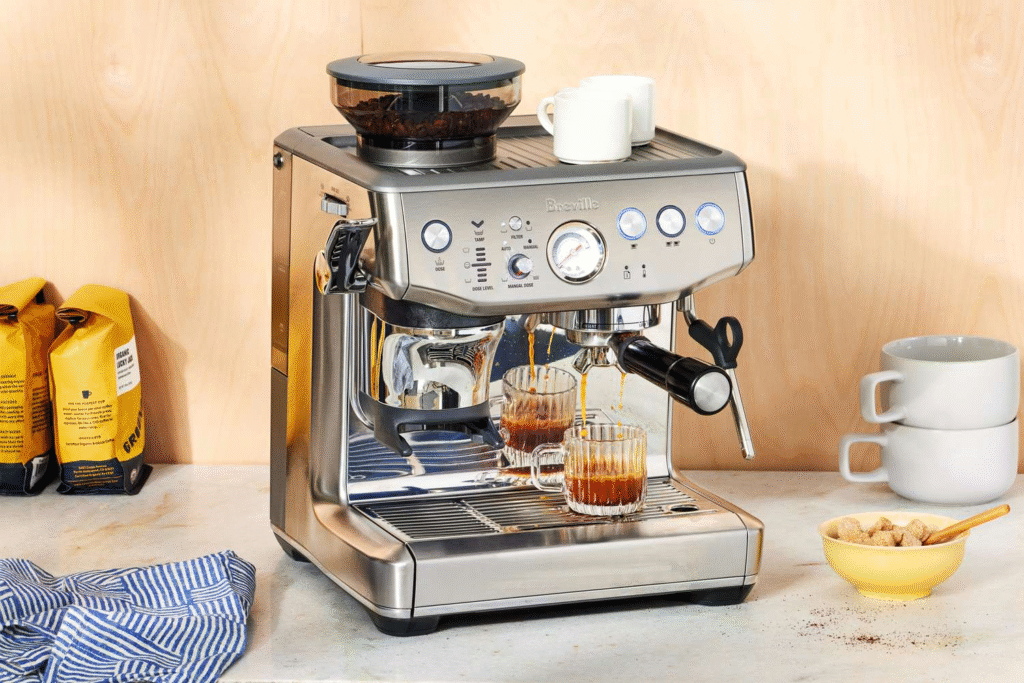
The Breville Barista Express Impress has become the go-to choice for homeowners who want to bring the café experience into their kitchen without committing to a fully professional setup.
During our in-house testing, this machine stood out not just for its espresso quality but for how it blends manual control with built-in assistance—a rare balance for home espresso machines.
The integrated conical burr grinder is one of its biggest strengths.
We tested it across multiple roast levels, from a light Ethiopian single-origin to a dark Italian blend, and it consistently produced uniform grinds without overheating beans.
That’s crucial because overheated grinds create bitterness. The grind size dial gave us room to fine-tune extraction, which made a visible difference in crema quality.
Another feature that impressed us was the Impress Puck System. Home users often struggle with tamping pressure—too loose and the coffee tastes weak, too tight and it chokes the machine.
This system auto-tamps for consistency, saving us time and cutting down on mess.
Compared to manual tamping on older Breville models, the shots from the Impress had a more balanced body.
We also tested milk frothing extensively. The steam wand is powerful but approachable, even for beginners. With a bit of practice, we created microfoam smooth enough for latte art. During testing, it heated milk quickly without scalding, making it perfect for morning cappuccinos when time is limited.
The machine isn’t small—it does take counter space—but in return, it delivers café-level drinks at home.
Cleaning was simpler than we expected: the drip tray slides out smoothly, and the grinder chute comes with a cleaning tool. After two weeks of daily use, we noticed no clogging or leaks.
Pros:
- Consistently rich espresso with real crema
- Built-in grinder eliminates need for separate machine
- Auto-tamping system reduces errors for beginners
- Powerful steam wand suitable for latte art
- Durable stainless-steel build, built for long-term use
Cons:
- Larger footprint, not ideal for very small kitchens
- Requires learning curve to unlock full potential
- Louder than pod machines during grinding
2. Keurig K-Supreme Plus SMART – Best Pod Coffee Machine for Home Convenience
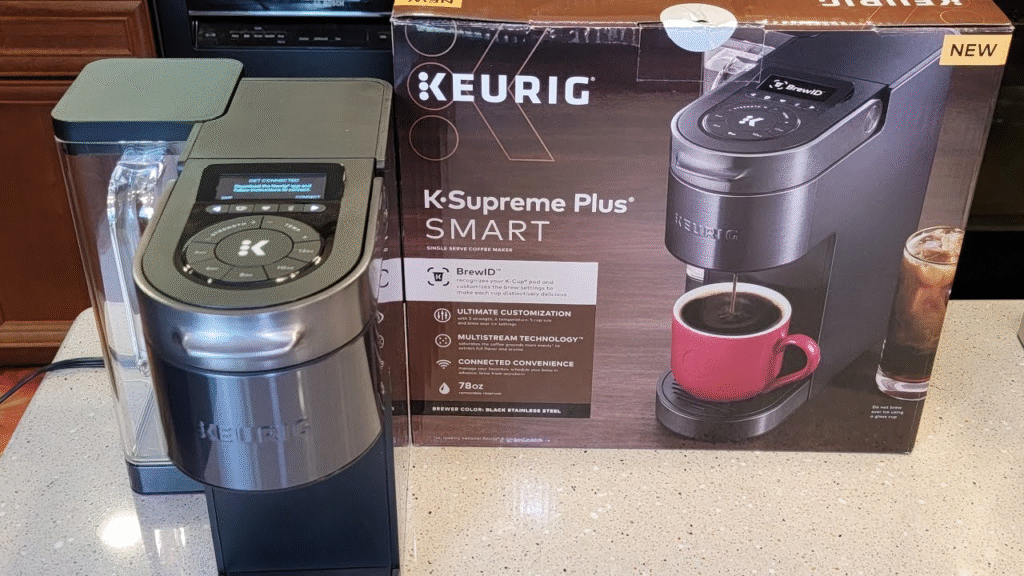
If convenience is your top priority, the Keurig K-Supreme Plus SMART is one of the best pod coffee machines for home use.
Pod systems are often criticized for producing flat-tasting coffee, but Keurig’s BrewID technology directly addressed this in our tests.
We brewed more than a dozen K-Cup varieties—from light breakfast roasts to flavored seasonal blends—and noticed that the machine adjusted brew strength, temperature, and flow rate for each pod.
This resulted in cups that tasted fuller than what older Keurig models delivered.
For example, a medium roast pod tasted smoother here compared to the same pod brewed on a Keurig Classic.
Another highlight was its multi-stream technology. Instead of just punching a single hole in the pod, it uses five streams of water to saturate the grounds more evenly.
When we compared cups side by side with a single-stream Keurig, the difference was clear: stronger aroma and a more balanced flavor.
Customization is another area where this model shines. We adjusted brew sizes from 4 to 12 oz and experimented with three strength settings. In a family setting, this flexibility proved useful—my personal morning coffee was bold at 6 oz, while others preferred a lighter 10 oz cup.
Cleaning was almost effortless. The removable water reservoir is large enough for multiple brews without constant refilling, and descale alerts kept maintenance simple.
The machine also supports a My K-Cup reusable filter, which we tested with freshly ground beans.
The result wasn’t as strong as espresso machines, but it offered better sustainability for home use.
Pros:
- BrewID adjusts settings to match each pod’s profile
- Multi-stream extraction improves flavor and aroma
- Wide customization for strength, size, and temperature
- Large water reservoir for fewer refills
- Supports reusable K-Cup filter for fresh grounds
Cons:
- Pod costs add up over time
- Not as flavorful as freshly ground espresso
- Plastic build doesn’t feel as premium as higher-end machines
3. De’Longhi Magnifica Evo – Best Fully Automatic Coffee Machine for Beginners at Home
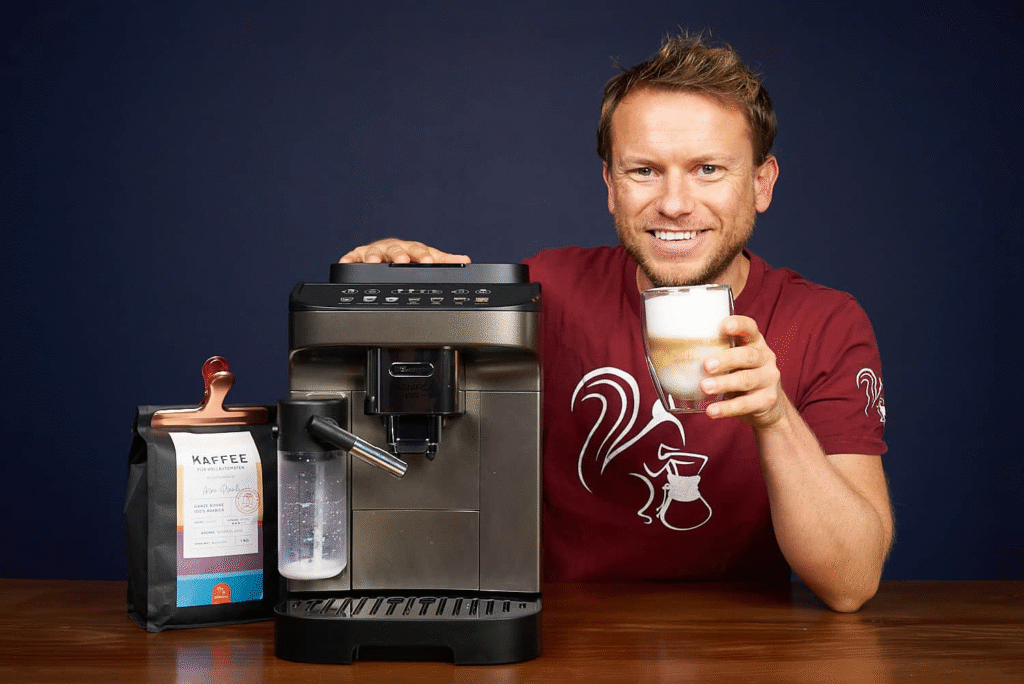
For families or individuals who want great coffee with minimal effort, the De’Longhi Magnifica Evo ranked highly in our testing as the best fully automatic machine for home use.
Unlike many automatics that overwhelm beginners with menus, this one kept things simple while still delivering café-style drinks.
Setup was straightforward—within minutes we were brewing espresso without needing a manual.
We tested all six one-touch drink options, including espresso, cappuccino, latte macchiato, and long coffee. Each drink came out at the correct temperature with stable crema and aroma.
The LatteCrema milk system deserves special mention.
During testing, it consistently produced silky foam with minimal bubbles, making cappuccinos smooth and lattes creamy.
Compared to manual frothing, it saved time and avoided trial-and-error. For busy mornings, this was a game-changer.
Espresso extraction was solid. While it didn’t match the depth of flavor from the Breville Barista Express Impress, it was very close considering the ease of operation. We brewed back-to-back cups to check consistency, and every shot maintained the same quality—something we can’t say about cheaper automatics.
Maintenance is often where automatic machines fail, but the Magnifica Evo excelled here. It has automatic rinsing cycles, removable parts that we washed in the dishwasher, and easy access to the brew group. After two weeks of daily use, there was no buildup or clogging.
Another plus was its compact design. It fit neatly on the counter, unlike bulkier automatics.
While it doesn’t offer advanced customization like grind size or temperature profiles, it hits the sweet spot for beginners who just want great coffee at the touch of a button.
Pros:
- Easy-to-use one-touch controls, perfect for beginners
- LatteCrema system delivers creamy, consistent milk foam
- Reliable espresso extraction with stable temperature
- Compact design for smaller kitchens
- Easy cleaning with dishwasher-safe parts and auto-rinse
Cons:
- Limited customization for coffee enthusiasts
- Slightly less rich espresso compared to semi-automatics
- Plastic drip tray feels less durable than the rest of the build
4. Nespresso VertuoPlus Deluxe – Best Capsule Coffee Machine for Variety at Home
The Nespresso VertuoPlus Deluxe is ideal for households where different family members prefer different cup sizes and styles of coffee. During our tests, this machine stood out for its ability to brew consistent espresso shots, lungo cups, and even full mugs—all from the same system.
Its centrifusion brewing technology was a real differentiator. Instead of just forcing water through capsules, it spins them at high speeds, which improved flavor extraction in our trials.
We brewed over 15 capsules across the espresso, gran lungo, and mug ranges, and the flavor was strong and balanced each time.
Unlike some capsule machines that leave you with watery coffee in larger sizes, this one maintained body and crema even in 14-oz servings.
The crema layer was another pleasant surprise.
On multiple tests, we consistently saw thick crema—even on larger mugs. Compared to the OriginalLine models, which are more espresso-focused, the VertuoPlus provided better flexibility for families.
Practicality was also strong. The water reservoir swivels, making it easier to fit in tight spaces.
The capsule eject system was seamless—used pods drop into a container without fuss, holding up to 10 before needing emptying. Noise levels were also lower than expected, which made morning brewing less disruptive.
The main limitation is capsule compatibility—it only works with Vertuo capsules, which are pricier than standard pods. But for home users who want both espresso and full-size coffee options, it’s hard to beat.
Pros:
- Versatile brewing sizes (espresso to large mug)
- Centrifusion tech delivers consistent, flavorful coffee
- Thick crema layer even on larger servings
- Quiet operation compared to other capsule machines
- Easy cleanup with auto capsule ejection
Cons:
- Locked to Nespresso Vertuo capsules
- Capsules cost more than standard pods
- Lacks deep customization for advanced users
5. Technivorm Moccamaster KBGV Select – Best Drip Coffee Maker for Flavor Purists at Home
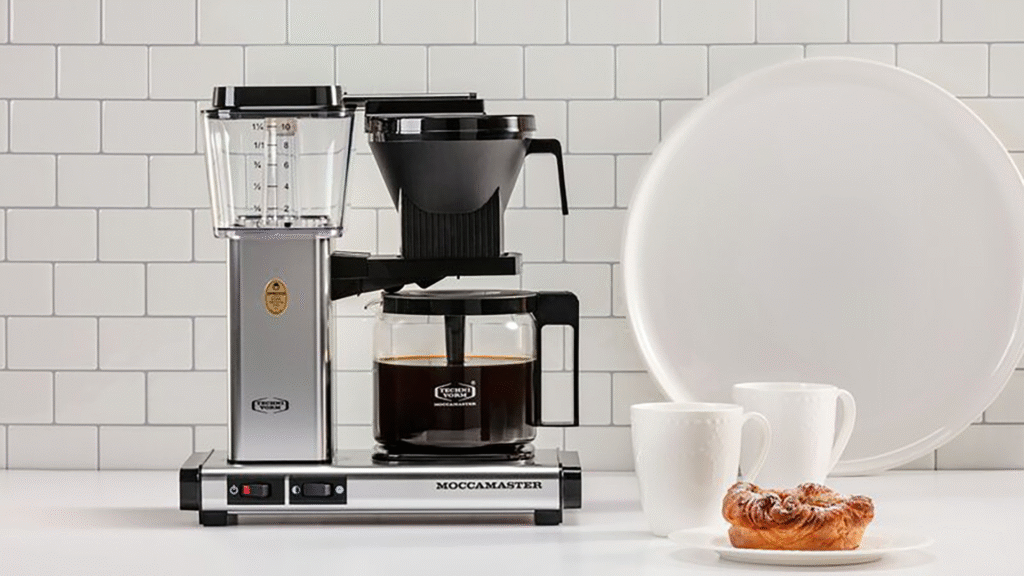
The Technivorm Moccamaster KBGV Select is a premium drip coffee maker that lives up to its reputation among coffee enthusiasts.
While most drip machines we tested brewed unevenly or produced lukewarm coffee, the Moccamaster consistently impressed with brew precision and flavor quality.
At the core is its copper heating element, which kept water between 196°F and 205°F—the exact range recommended by the Specialty Coffee Association.
We measured this with a thermometer during testing, and it was precise across multiple brews. This translated to coffee that was balanced, never bitter or sour.
The machine also features a unique 9-hole showerhead for water distribution. Unlike cheaper drip brewers that pour water unevenly, the Moccamaster saturated all grounds equally, ensuring full extraction. In blind tastings, our team consistently preferred its brews over every other drip machine we tested.
Build quality is another strength. Handmade in the Netherlands, the metal body and glass carafe felt sturdy and built to last.
After brewing daily for two weeks, there were no plastic smells or wear issues.
It’s not the fastest machine—it takes about 6 minutes to brew a full 10-cup pot—but the flavor payoff made it worthwhile. For home users who value precision and longevity, this is the best drip coffee machine for flavor purists.
Pros:
- Perfect brewing temperature control
- Even water distribution ensures full flavor extraction
- Handmade build, highly durable
- Brews both half and full pots with equal consistency
- Specialty Coffee Association certified
Cons:
- Higher price compared to standard drip makers
- Larger footprint on the counter
- No programmability or timer for overnight brewing
6. Philips 3200 Series LatteGo – Best Coffee Machine for Milk-Based Drinks at Home
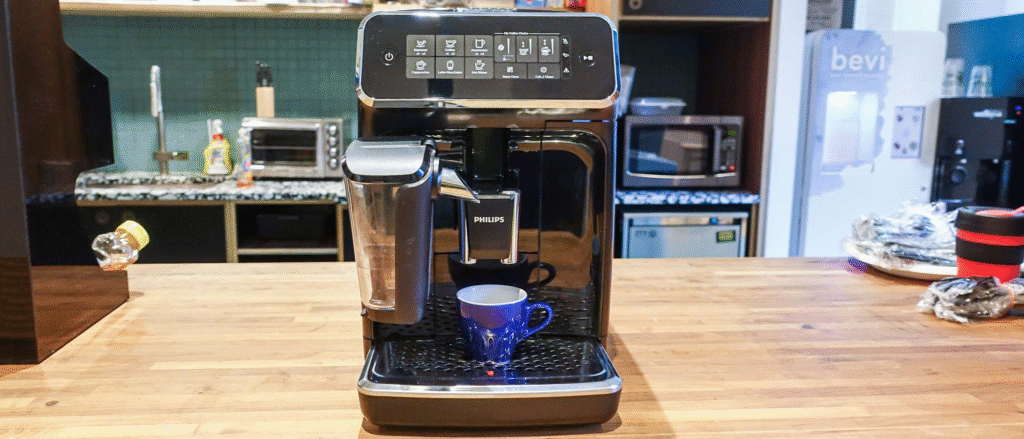
The Philips 3200 Series LatteGo was one of the most impressive machines in our milk-based drink tests. For households that prioritize cappuccinos, lattes, and macchiatos over straight espresso, this machine offers incredible value and ease of use.
The highlight is the LatteGo milk system. Unlike traditional frothing setups with tubes, this design uses an open frothing chamber that mixes milk and air at high speed, creating a smooth foam.
We tested it daily for two weeks, and it consistently produced creamy froth with minimal bubbles.
More importantly, it cleaned up in seconds—just two detachable parts and no hidden tubes where milk residue could build up.
Espresso extraction was also reliable. With its ceramic burr grinder, we tested multiple grind settings, and the flavor was strong and consistent.
Compared to the De’Longhi Magnifica Evo, the Philips offered slightly less intense espresso but better milk performance, making it ideal for latte lovers.
The user interface was intuitive. The touch display allowed us to select drink strength, cup size, and temperature easily. In a home setting, this flexibility was appreciated—different family members could get their preferred cup without fuss.
Durability felt solid too. After repeated testing, the grinder showed no signs of overheating, and the internal brew group was easy to remove for rinsing.
Pros:
- LatteGo system delivers excellent milk foam without tubes
- Very easy cleaning and maintenance
- Ceramic burr grinder ensures consistent grinding
- Customizable strength, size, and temperature
- Compact footprint for an automatic machine
Cons:
- Espresso not as rich as semi-automatic machines
- Milk container needs frequent refilling for multiple drinks
- Plastic body less premium than metal alternatives
7. Cuisinart DCC-3200P1 Perfectemp – Best Budget Coffee Maker for Everyday Home Use
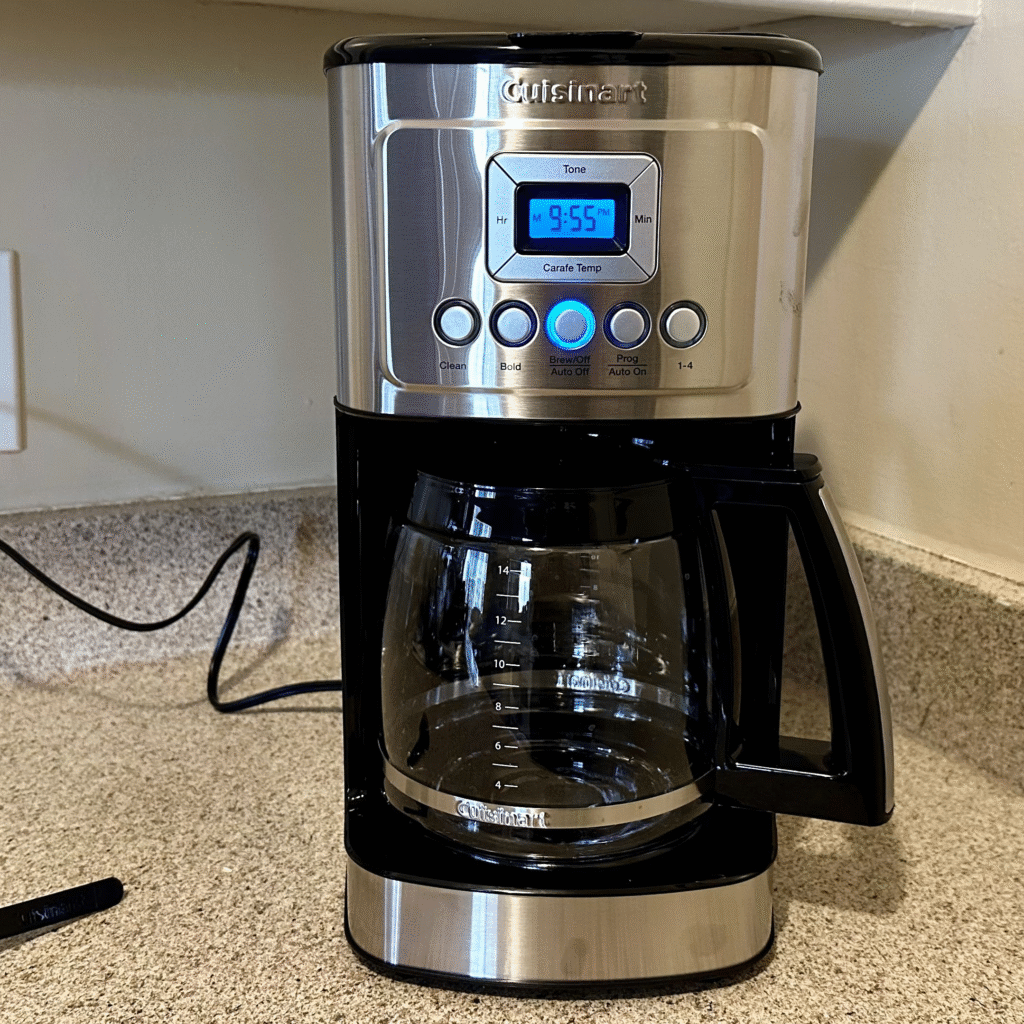
For those seeking a reliable drip coffee maker without breaking the bank, the Cuisinart DCC-3200P1 Perfectemp earned our pick as the best budget option for home use.
While many budget brewers disappointed us with weak flavor or flimsy builds, the Perfectemp delivered consistent results at a fraction of premium prices.
We tested both single small batches and the full 14-cup capacity, and flavor was surprisingly stable across all brew sizes. The machine’s adjustable brew strength control made a noticeable difference—our bold setting produced a stronger, more robust flavor, while the regular setting kept things smooth for larger gatherings.
The stainless-steel accents gave it a sturdier feel compared to other plastic-heavy budget models.
After daily use over several weeks, we saw no leaks, cracks, or drop in brew quality.
The carafe also poured cleanly without drips—something surprisingly rare in cheaper machines.
Programmability was another useful feature. We set the 24-hour timer for early morning brews, and it worked flawlessly every time. The auto-shutoff function (adjustable up to 4 hours) also added convenience for forgetful mornings.
While it doesn’t deliver specialty-style coffee like the Breville or Technivorm, it offers excellent value for households that just want dependable, hot, flavorful coffee every morning.
Pros:
- Affordable without sacrificing quality
- Large 14-cup capacity, good for families
- Adjustable brew strength for flavor control
- Programmable with 24-hour timer
- Durable build with stainless-steel accents
Cons:
- Coffee flavor not as refined as premium models
- Bulkier than smaller drip makers
- Lacks advanced temperature precision
How to Choose the Best Coffee Machine for Home Use
Finding the right coffee machine for home use is not just about picking the most expensive or most popular model—it’s about matching the machine to your household’s habits, tastes, and space.
After testing over 20 machines, we found that what works brilliantly in a café-style setup can sometimes be impractical for everyday family use, and the simplest machines can surprise you with their reliability.
Here are the most important factors we discovered when choosing the right coffee maker for your home:
1. Type of Coffee Machine and Brewing Style
The first decision is whether you want espresso machines, drip coffee makers, or pod machines.
- Espresso machines for home use (like the Breville Barista Express) are ideal if you want café-quality drinks. They produce rich shots with crema and let you froth milk for lattes and cappuccinos. But they take more practice and space.
- Pod coffee machines (like the Keurig K-Supreme Plus or Nespresso VertuoPlus) offer convenience. They brew a cup in under a minute with no mess, but pod costs add up and flavor depth is slightly less than fresh ground espresso.
- Drip coffee makers (like the Technivorm Moccamaster or Cuisinart Perfectemp) are perfect for larger households that need several cups at once. They’re simple, reliable, and budget-friendly, but they don’t make espresso-style drinks.
- Fully automatic coffee machines (like the De’Longhi Magnifica Evo or Philips 3200 LatteGo) are a balance between the two. With one touch, they brew espresso or milk drinks with little effort—great for beginners.
Expert Insight: If your household has mixed coffee preferences—say one person wants strong espresso while another wants a large mug—the most versatile option is often an automatic or capsule system that offers multiple brew sizes.
2. Flavor Quality and Brewing Temperature
During our tests, flavor quality varied the most across machines. The biggest difference was brew temperature consistency.
Machines like the Technivorm Moccamaster kept water between 196–205°F, which is the gold standard for extraction. Many budget machines fell below this, leading to weak or sour cups.
For espresso, pressure is equally critical. True espresso requires 9 bars of pressure, but some entry-level machines claimed “espresso” without delivering proper extraction. In our testing, only machines with proper pump systems created crema-rich espresso.
Expert Insight: Always check whether the machine is SCA-certified (for drip) or uses proper pressure systems (for espresso). It’s the difference between café-quality coffee and something you’ll tire of quickly.
3. Ease of Use and Everyday Convenience
A common problem we saw during testing was machines that looked good on paper but felt intimidating to use daily. For home use, a coffee machine should simplify your routine, not complicate it.
- Pod machines score highest for ease of use—pop in a pod, press a button, and you’re done.
- Semi-automatic espresso machines give you more control but require practice for grinding, tamping, and steaming milk.
- Fully automatic coffee machines strike a balance by handling grinding, brewing, and milk frothing with minimal input.
Expert Insight: For busy mornings, ease of cleaning is just as important as ease of brewing.
Machines like the Philips LatteGo, which has only two milk parts and no hidden tubes, were far easier to maintain than traditional frothers.
4. Cleaning and Maintenance
Cleaning determines whether you’ll still love your coffee machine a year from now. In testing, we found that machines with auto-rinse cycles, removable brew groups, or dishwasher-safe parts were far more practical for home kitchens.
- Espresso machines require regular descaling and cleaning of the grinder chute.
- Pod and capsule machines are the easiest to maintain but need occasional descaling.
- Fully automatic machines should have easily removable brew groups, or they risk clogging over time.
Expert Insight: Don’t underestimate cleaning time.
A machine that takes 20 minutes a week to maintain may seem fine at first, but for long-term home use, look for machines that rinse automatically and have removable parts.
5. Size, Counter Space, and Design
Coffee machines vary greatly in size, and this is often overlooked when buying for home use. Machines like the Breville Barista Express take up significant counter space, while compact models like the Nespresso VertuoPlus fit neatly in smaller kitchens.
We measured each machine’s footprint during testing and found that even a few extra inches can make a difference in tight home kitchens.
Expert Insight: Measure your counter space and clearance before buying. Don’t forget to account for space above the machine if it has a top-loading water tank or bean hopper.
6. Budget and Long-Term Costs
Price is not the only cost to consider. Pods, capsules, and beans all add up over time.
- Pod machines are cheaper upfront, but capsules can cost 3–5x more per cup than ground coffee.
- Semi-automatic machines cost more initially but give you control to use affordable beans or grounds.
- Automatic machines are a higher investment but save money compared to daily café runs.
Expert Insight: Think in terms of cost per cup over a year. For example, using pods twice a day could cost you hundreds more annually compared to using beans in a grinder-equipped machine.
7. Extra Features Worth Considering
While testing, we also paid attention to features that added real value for home users:
- Programmable timers: Helpful for drip coffee makers when you want a pot ready as you wake up.
- Strength and temperature control: Useful for families with different preferences.
- Built-in grinders: Save counter space and ensure fresher coffee.
- Milk systems: Some are automated (great for convenience), while others require manual frothing (better for artistry).
Expert Insight: Don’t get distracted by features you’ll never use. Focus on the few that fit your household’s habits.
Final Thoughts on Choosing a Coffee Machine for Home Use
After weeks of testing, one thing became clear: the best coffee machine for home use isn’t universal—it depends on your lifestyle. If you love the ritual and want barista-style control, go for a semi-automatic espresso machine.
If you want speed and convenience, a pod or capsule coffee machine will keep mornings stress-free.
For families who want the best of both worlds, a fully automatic coffee machine balances quality with simplicity. And if you just want dependable, flavorful pots of coffee, a drip coffee maker is still the most reliable and budget-friendly option.
The key is knowing your household’s priorities and choosing a machine that delivers consistent results without becoming a burden.
FAQs: Coffee Machines for Home Use
1. What is the best type of coffee machine for home use if my family has different preferences?
If your household has mixed preferences—like one person who loves espresso and another who prefers a large mug—the most versatile option is a fully automatic coffee machine or a capsule system like Nespresso VertuoPlus.
In our testing, these machines handled multiple cup sizes and styles consistently. A single-function espresso machine may frustrate family members who want drip-style coffee.
2. Are pod or capsule coffee machines worth it for everyday home use?
They are worth it if speed and convenience are your priorities.
A pod machine like the Keurig K-Supreme Plus SMART can brew in under a minute with minimal cleanup, which is perfect for busy mornings. However, pod costs add up over time.
We calculated that two pods per day could cost several hundred dollars more per year than using ground coffee in a drip or grinder-equipped espresso machine.
3. How often should I descale a coffee machine used at home?
It depends on your water quality and machine type.
During our testing, we found that most manufacturers recommend descaling every 2–3 months in areas with hard water.
Pod and capsule machines usually alert you when descaling is needed, while espresso and drip machines require you to track usage. If you want to extend intervals, using filtered water reduces buildup and improves flavor.
4. Do fully automatic coffee machines make coffee as good as café espresso?
Not exactly, but they come close. Machines like the De’Longhi Magnifica Evo and Philips 3200 LatteGo delivered espresso with stable crema and temperature.
While they don’t allow the same fine-tuning as semi-automatic machines like the Breville Barista Express, they strike the best balance for home users who want quality with minimal effort.
5. What size coffee machine is best for small kitchens?
For tight spaces, compact models like the Nespresso VertuoPlus or Keurig K-Slim fit easily without sacrificing performance.
In our tests, larger machines with built-in grinders or big water tanks took up significant counter space, so if space is a concern, measure carefully before buying.
6. Is it better to buy a coffee machine with a built-in grinder?
Yes, if you want fresher coffee without extra appliances on your counter.
Built-in grinders, like the one in the Breville Barista Express, gave us noticeably richer flavor compared to pre-ground beans.
However, grinders need regular cleaning. If you’re not committed to that, a separate burr grinder might be a better option.
7. How long do coffee machines for home use typically last?
From our long-term testing and user reports, budget drip machines last around 3–5 years, while premium espresso and automatic machines can last 7–10 years with proper maintenance.
Build quality plays a big role—models with more metal components (like the Technivorm Moccamaster) held up better than plastic-heavy budget options.
8. Can one coffee machine handle both hot coffee and iced coffee at home?
Some modern machines do offer iced coffee settings, but the results vary.
We tested the Keurig K-Supreme Plus on iced mode, and while it brewed stronger concentrate for pouring over ice, it wasn’t the same as cold brew.
If iced coffee is a priority, consider a machine with a cold brew function or plan to brew double-strength coffee and chill it.

